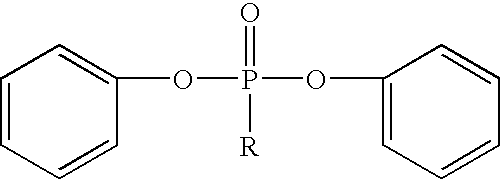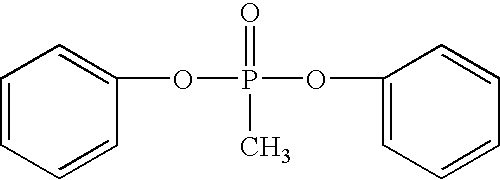Insoluble and Branched Polyphosphonates and Methods Related Thereto
a polyphosphonate and branched technology, applied in the field of insoluble branched polyphosphonates, can solve the problems of low molecular weight polyphosphonates that exhibited poor toughness, polyphosphonates exhibited high melt viscosity, processability was sacrificed,
- Summary
- Abstract
- Description
- Claims
- Application Information
AI Technical Summary
Benefits of technology
Problems solved by technology
Method used
Image
Examples
example 1
State of the Art: Preparation of Branched Polyphosphonates Using Phenolate Catalyst
[0049]A branched polyphosphonate was prepared as described in U.S. Pat. No. 4,415,719 using the reaction scheme:
[0050]A reaction mixture containing 33.28 g (0.1457 moles) 2,2-bis(4-hydroxyphenyl)propane (bisphenol A), 37.07 g (0.1493 mole) methylphosphonic acid diphenyl ester and 0.006 g (5.16×10−5 moles) sodium phenolate and 0.459 g (1.5×10−3 moles) of 1,1,1-tris(4-hydroxyphenyl)ethane (branching agent) was prepared. This reaction mixture contains a 2.4 mole % molar excess of bisphenol A relative to phosphonic ester and 3.54×10−4 moles of sodium phenolate per 1 mole of bisphenol A. This reaction mixture was heated to from 250° C. to 300° C. under vacuum for approximately 8 hours.
[0051]The polymer isolated was not as tough as the polymers described in Examples 2 and 3. A 0.5% solution of the polymer in methylene chloride exhibited a relative viscosity of about 1.09 at 23° C., and a film cast from meth...
example 2
State of the Art: Preparation of Polyphosphonates Using a Tetraphenylphosphonium Catalyst as Described in EP 04714123.0
[0052]Into a 12 L reactor equipped with a distillation column and mechanical stirrer was placed 3.329 kg 2,2-bis-(4-hydroxyphenyl)propane (bisphenol A), 1.2 g tetraphenylphosphonium phenolate catalyst, 89 g 1,1,1 Tris(4-hydroxyphenyl)ethane and 3.581 kg methylphosphonic acid diphenyl ester. Phenol (0.224 kg) is evolved from methylphosphonic acid diphenyl ester and is also present in the reaction mixture. The mixture was heated to from 250° C. to 300° C. while reducing the pressure from 150 to 1.5 mm Hg over about a 14.5 hour period. A noticeably rapid increase in solution viscosity of the melt was observed over the last hour of the reaction.
[0053]Approximately 3428 g of distillate was collected over the course of the reaction. The polyphosphonate was extruded out of the reactor as a strand and cut into granules using a granulator. The yield of polyphosphonate out o...
example 3
Preparation of Insoluble Polyphosphonates Using Sodium Phenolate Catalyst
[0054]Into a 12 L reactor equipped with a distillation column and mechanical stirrer was placed the 3.329 kg 2,2-bis-(4-hydroxyphenyl)propane (bisphenol A), 0.6 g sodium phenolate catalyst, 89 g 1,1,1 tris(4-hydroxyphenyl)ethane and 3.581 kg methylphosphonic acid diphenyl ester. Phenol (0.093 kg) is evolved from methylphosphonic acid diphenyl ester and is also present in the reaction mixture. The mixture was heated from 250° C. to 300° C. while reducing the pressure from 150 to 1.5 mm Hg over about a 14 hour period. A noticeably rapid increase in solution viscosity of the melt was observed over the last hour of the reaction.
[0055]Approximately 3253 g of distillate was collected over the course of the reaction. The polyphosphonate was extruded out of the reactor as a strand and cut into granules by granulator. The yield of polyphosphonate out of the reactor was 3748 g with a percentage of phosphorous of about 10...
PUM
| Property | Measurement | Unit |
|---|---|---|
| Tg | aaaaa | aaaaa |
| dispersities | aaaaa | aaaaa |
| Tg | aaaaa | aaaaa |
Abstract
Description
Claims
Application Information
 Login to View More
Login to View More - R&D
- Intellectual Property
- Life Sciences
- Materials
- Tech Scout
- Unparalleled Data Quality
- Higher Quality Content
- 60% Fewer Hallucinations
Browse by: Latest US Patents, China's latest patents, Technical Efficacy Thesaurus, Application Domain, Technology Topic, Popular Technical Reports.
© 2025 PatSnap. All rights reserved.Legal|Privacy policy|Modern Slavery Act Transparency Statement|Sitemap|About US| Contact US: help@patsnap.com



